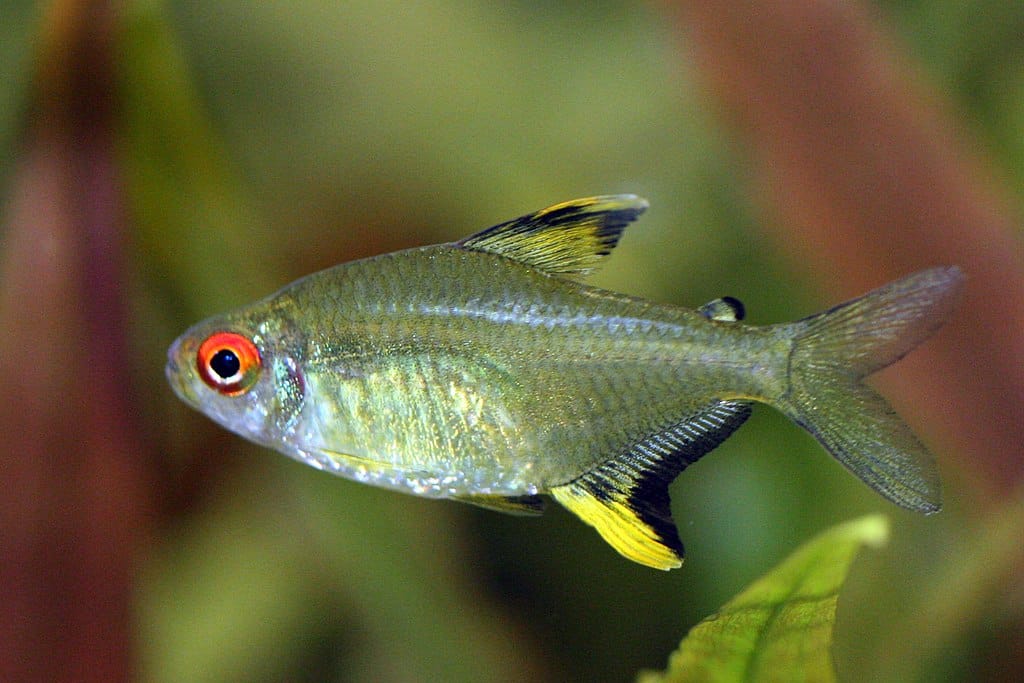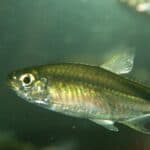The Lemon Tetra (Hyphessobrycon pulchripinnis) is a fascinating fish, both for its appearance and size. They are found in South America in the Tapajós River basin region. Although their bodies are transparent, they have a lemony color if they are well cared for and fed a suitable diet.

Species Summary
Spread over a wide area of the Amazon region in central Brazil, the Lemon Tetra is a species of tropical freshwater tetra belonging to the Characidae family. The species occurs in different streams, flooded forest areas, and shallow lakes, both on densely vegetated banks and cleaner places.
These tetras reach an ideal size for an aquarium in addition to different and eye-catching colors, causing a unique impact on the viewer when in large schools. It is one of the most common species in domestic aquariums worldwide. They have been raised in captivity for years and are an excellent species for beginners.
Overall, Lemon Tetra is a hardy fish and relatively easy to spawn, making it an ideal choice for beginner aquarists.
Care Guide
These fish are very adaptable and can live in community aquariums with other peaceful fish without any problems. Like other tetras, the Lemon Tetra must be kept in groups of at least six individuals of the species. They are found in large schools containing thousands of them in the wild.
When well cared for, the Lemon Tetra is a magnificent fish. They will show their best colors when given a balanced diet and in a suitable aquarium.
It is a resistant and easy-to-care fish, but that does not exclude knowing the species, its habits, and behaviors in depth. Like any other species, Lemon Tetra has its peculiarities, addressed and detailed in the following topics.
Tank Size
Lemon Tetras are very active fish and should be kept in schools, with ample free space for swimming. A 30” x 12” or 26-gallon tank is a good size to start with a small school. But like most shoal fish, the more space and the bigger the shoal, the better for the well-being of the fish.
Tankmates
As they are peaceful fish and coexist without problems with other animals, they can live with countless other species of fish in a community aquarium. Avoid aggressive species that could harm Lemon Tetras or compete directly for food.
This species may come to bite fish with very flashy and exuberant fins, such as Bettas and Guppies; in this case, pay extra attention to the aquarium.
Same Species Tanks
They are often used as a single species in assemblages of Biotope-type aquariums, where the original location where the species occurs is imitated.
It is a great species to be kept alone in a well-decorated aquarium, a large school with many beautiful movements, and a flurry of colors that decorate any room.
Water Parameters
They are incredibly resilient fish, which support a wide range of parameters.
This tetra can live with outstanding quality of life in different parameters; the perfect temperature for its maintenance is 68 to 84 F. The ideal pH range is between 5.0 to 7.5 and hardness from 18 to 215 ppm.
This difference between hardness and pH is related to the region of origin of the specimen and demonstrates the range of parameters during the dry and rainy seasons.
What to Put in Their Tank
As for any other aquatic animal, an aquarium heater and a filtering system are essential to keep the tank with Lemon Tetra healthy. The filtration system should be well dimensioned, but this species inhabits slow-flowing waters without creating a solid flow in the water.
This species can inhabit either fine sand ponds with driftwood and a bed of dry leaves or densely planted aquariums; it will feel good in both environments, but they are more colorful when kept in a densely planted aquarium. Sandy, dark substrate further enhances your colors.
They prefer well-planted aquariums that have open spaces for free swimming.
Common Diseases
They are extremely disease resistant fish. Keeping the quality of the water and the pond always in excellent condition and providing good quality food will reduce the likelihood of any problems. Like any other tetra, which may be prone to Neon Tetra Disease (NTD), quarantine new fish before placing them in the main aquarium.
Food and Diet
This species, like other Tetras, is omnivorous, feeding on small invertebrates, algae, biofilm, fruits that fall into the water, and small fish.
Its primary diet is based mainly on small invertebrates and algae in its natural environment. This fish accepts commercial feeds without problems in aquariums, being great eaters. Dry, live, and fresh foods such as daphnia, brine shrimp, bloodworms, mosquito larvae, and others are highly beneficial to fish.
Providing a varied and balanced diet is essential for demonstrating its full potential. These are usually fish that are always hungry.
Lifespan
In an aquarium with all the correct parameters kept stable and with an ideal diet, this tetra can live for up to 8 years, with the most common being around 4 to 6 years.
In nature, these animals live less, as they are predisposed to diseases, attacks from other animals, and environmental causes.
Appearance
Adult Lemon Tetras appear both familiar and distinct in appearance, with translucent, diamond-shaped bodies (similar to other tetras), with parts of the body edge and fins tinged yellow, with black and yellow spots on their anal and dorsal fins. Females of this tetra fish have more robust bodies than male fish.
Size
In aquariums, Lemon Tetra fish can easily grow to 2 inches in length when well cared for and fed.
Behavior and Temperament
It is a tropical fish species with peaceful behavior and can be kept in a community aquarium with fish of the same size. As it is a fish with gregarious habits, it will be important to keep a school of at least 10 animals so that they show their natural behavior and more enhanced colors.
They are very active animals, occupying practically all strata of the tank, however they prefer to feed on the surface.
Breeding
Captive breeding is carried out commercially and in domestic aquariums worldwide without significant problems.
It is an oviparous species, where the female dumps the eggs in the middle (egg-scattering species). The male will lead the female to release the eggs freely, which will then be fertilized by him; most of the eggs will go to the bottom of the aquarium or will be in the middle of a clump of plants. Eggs hatch within three days, and larvae will be free-swimming within 48 hours. Parents do not exhibit any parental care.
They prefer to breed in slightly acidic waters. They are usually used in aquariums specifically set up for breeding, with something on the bottom that prevents the parents from eating the eggs until they are removed to another location. The fingerlings are tiny; they must be fed with paramecium or another type of infusoria until they are big enough to accept other foods.
They are easily reproduced fish, where spontaneous reproduction can occur in any domestic aquarium, as long as it is well taken care of.
Gender Differences: Male vs. Female
There is apparent sexual dimorphism; males are slightly smaller and have a more straight body, while females have a more robust body with a plumper shape. Adult males are more colorful, especially in the dorsal and anal fins; the color is usually the most used characteristic for sexing.
Fun Facts
This species is prevalent in the aquarium hobby and commercially reproduced in several countries, including the albino form.
Its name, Hyphessobrycon, comes from the Greek hyphesson, which means short of stature + Greek bryko = biting, biter. Pulchripinnis, from the Latin pulcher, meaning “beautiful,” and pinna, meaning “fin,” referencing the black and yellow dorsal and anal fins.
The actual area of occurrence of the species is still a mystery; populations have already been observed in other basins such as the Xingu River and Amazonas.
References
Ahl, E., 1937 – Zoologischer Anzeiger 120(9/10): 235-236
Über einen neuen südamerikanischen Characiniden der Gattung Hyphessobrycon.
Bundesministerium für Ernährung, Landwirtschaft und Forsten (BMELF), 1999. Gutachten über Mindestanforderungen an die Haltung von Zierfischen (Süßwasser). Bundesministerium für Ernährung, Landwirtschaft und Forsten (BMELF), Bonn, Germany.
Burt, A., D.L. Kramer, K. Nakatsuru and C. Spry, 1988. The tempo of reproduction in Hyphessobrycon pulchripinnis (Characidae), with a discussion on the biology of ‘multiple spawning’ in fishes. Environ. Biol. Fish.
Camargo, M., T. Giarrizzo, and V. Isaac, 2004 – Ecotropica 10: 123-147
Review of the geographic distribution of fish fauna of the Xingu river basin, Brazil.
Lucena, C.A.S. and N.A. Menezes, 2003. Subfamily Characinae (Characins, tetras). p. 200-208. In R.E. Reis, S.O. Kullander and C.J. Ferraris, Jr. (eds.) Checklist of the Freshwater Fishes of South and Central America. Porto Alegre: EDIPUCRS, Brasil.
Mills, D. and G. Vevers, 1989. The Tetra encyclopedia of freshwater tropical aquarium fishes. Tetra Press, New Jersey. Reis, R. E., S. O. Kullander and C. J. Ferraris, Jr. (eds), 2003 – EDIPUCRS, Porto Alegre: i-xi + 1-729
Check list of the freshwater fishes of South and Central America. CLOFFSCA.








